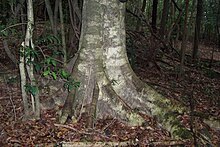| Silver quandong | |
|---|---|

| |
| Elaeocarpus kirtonii growing at Morton National Park | |
| Scientific classification | |
| Kingdom: | Plantae |
| Clade: | Tracheophytes |
| Clade: | Angiosperms |
| Clade: | Eudicots |
| Clade: | Rosids |
| Order: | Oxalidales |
| Family: | Elaeocarpaceae |
| Genus: | Elaeocarpus |
| Species: | E. kirtonii |
| Binomial name | |
| Elaeocarpus kirtonii F.Muell. ex F.M.Bailey | |
| Synonyms | |
| |

Elaeocarpus kirtonii, commonly known as silver quandong, white quandong, brown hearted quandong, brownheart, mountain beech, Mowbullan whitewood, pigeonberry ash, white beech or whitewood, is species of flowering plant in the family Elaeocarpaceae and is endemic to eastern Australia. It is a large rainforest tree with buttress roots, regularly toothed, narrow elliptic to narrow oblong leaves, racemes of white flowers and pale blue, oval fruits.
Description
Elaeocarpus kirtonii is a large and often dominant tree, typically growing to a height of 30 m (98 ft) with a diameter of about 1 m (3 ft 3 in), but sometimes to 45 m (148 ft) and 2 m (6 ft 7 in) diameter. There are buttress roots to a height of 3 m (9.8 ft) and the outer bark is silvery grey and thin, with small pustules. New growth is salmon-pink, the leaves clustered near the ends of the branchlets, narrow elliptic to narrow oblong, 70–200 mm (2.8–7.9 in) long and 20–40 mm (0.79–1.57 in) wide on a petiole 15–50 mm (0.59–1.97 in) long. The leaves are dull green with prominent veins, regularly spaced teeth on the edges and turn red before falling. The flowers are arranged along racemes mostly 60–100 mm (2.4–3.9 in) long with between fifteen and twenty sweet-scented flowers, each on a pedicel up to 6–10 mm (0.24–0.39 in) long. The five sepals are very narrow egg-shaped to triangular, 5.5–6 mm (0.22–0.24 in) long and 1.5 mm (0.059 in) wide. The five petals are white, 7.5–10 mm (0.30–0.39 in) long and 2.5–3 mm (0.098–0.118 in) wide with about twenty-four linear lobes at the tip. There are between twenty-five and thirty stamens. Flowering occurs from January to March and the fruit is a pale blue, oval drupe 10–13 mm (0.39–0.51 in) long, maturing from October to January and containing a hard, sculptured stone.
Taxonomy
Elaeocarpus kirtonii was first formally described in 1886 by Frederick Manson Bailey in A Synopsis of the Queensland Flora, from an unpublished description by Ferdinand von Mueller. The specific epithet (kirtonii) honours W. Kirton, who collected samples of the tree at Bulli in 1885 for Ferdinand von Mueller.
Distribution and habitat
Silver quandong grows from near Milton (35° S) in New South Wales to Eungella National Park (20° S) in tropical Queensland. It grows in tropical, sub-tropical and warm temperate rainforests but is often also seen in cooler and moister sites on volcanic soils and on the richer alluvial soils.
Ecology
The fruit of E. kirtonii is eaten by a large variety of rainforest birds.
Conservation status
This quandong is listed as of "least concern" under the Queensland Government Nature Conservation Act 1992.
References
- ^ "Elaeocarpus kirtonii". Australian Plant Census. Retrieved 17 February 2021.
- ^ "Elaeocarpus kirtonii". Royal Botanic Garden Sydney. Retrieved 17 February 2021.
- Hyland, Bernard; Coode, Mark J. (1984). "Elaeocarpus in Australia and New Zealand". Kew Bulletin. 39 (3): 554–557.
- ^ Floyd, Alexander G. (1989). Rainforest trees of mainland South-eastern Australia. Melbourne: Inkata Press. p. 115. ISBN 0-909605-57-2.
- "Elaeocarpus kirtonii". APNI. Retrieved 17 February 2021.
- Bailey, Frederick M. (1886). A Synopsis of the Queensland Flora. Brisbane: Queensland Government Printer. p. 8. Retrieved 17 February 2021.
- "Species profile—Elaeocarpus kirtonii (silver quandong)". Queensland Government Department of Environment and Science. Retrieved 17 February 2021.